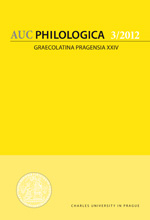La raffigurazione della „lamia“ nel Vocabularius dictus Lactifer e le sue origini antiche e medievali
The Depiction of the “Lamia” in vocabularius Dictus Lactifer and Its Ancient and Medieval Origins
Author(s): Hana ŠedinováSubject(s): Language and Literature Studies
Published by: Univerzita Karlova v Praze, Nakladatelství Karolinum
Summary/Abstract: The term lamia had two meanings in the classical period: in Greek mythology it was a female monster of bestial behaviour and of physical characteristics of an animal, killing infants; in zoological treatises the term designs a shark. Under the influence of biblical commentaries and of medieval texts dealing with wonders of remote lands, and maybe as a consequence of misunderstanding of Aristotle’s text, new meanings of the word appear in the Middle Ages and the term lamia designs various creatures: a night demon, an unidentifiable quadruped, a hyena, a terrifying nocturnal flying creature, a domestic animal kept for milk and a female or sea monster with horse legs. These new meanings are reflected also in the late medieval lexicon of Czech provenience, the Vocabularius dictus Lactifer, written at the beginning of 16th century by a Franciscan monk Iohannes Aquensis.
Journal: Acta Universitatis Carolinae Philologica
- Issue Year: 2012
- Issue No: 3
- Page Range: 113-124
- Page Count: 12
- Language: Italian

